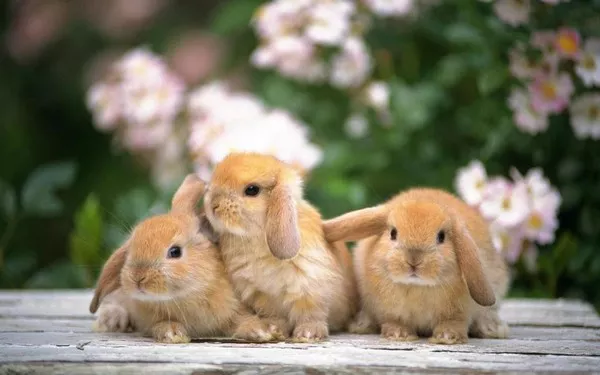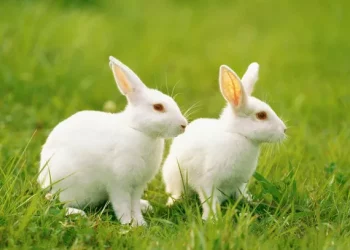Hay is an essential part of a rabbit‘s diet, providing not only the necessary fiber for digestive health but also ensuring proper dental wear and overall well-being. Ensuring that the hay provided is clean and free from dust is crucial, as dusty hay can pose several health risks to rabbits. This article will delve into the importance of hay, the causes of dusty hay, and practical methods to reduce dust, ensuring your rabbit enjoys clean, healthy hay.
The Role of Hay in a Rabbit’s Diet
Hay constitutes the majority of a rabbit’s diet, with many veterinarians recommending that it should make up approximately 80-90% of their daily intake. The high fiber content in hay is vital for maintaining a rabbit’s digestive system, preventing issues such as GI stasis, which can be life-threatening. Additionally, chewing on hay helps wear down a rabbit’s teeth, which continuously grow throughout their life, preventing dental problems that can lead to pain and difficulty eating.
Benefits of Providing Clean and Dust-Free Hay
Providing clean, dust-free hay ensures that rabbits can eat without the risk of respiratory issues. Dust can irritate a rabbit’s sensitive respiratory system, leading to conditions such as sneezing, coughing, and in severe cases, respiratory infections. Clean hay also ensures that your rabbit can enjoy their food without any discomfort or health risks, promoting overall happiness and well-being.
Causes of Dusty Hay
Common Reasons Why Hay Becomes Dusty
Hay can become dusty due to several factors, including:
Harvesting and Processing Methods: During harvesting, the cutting and baling process can break down the hay into smaller particles, creating dust.
Storage Conditions: Poor storage conditions, such as high humidity, can lead to mold growth, which breaks down hay into dust.
Handling and Transport: Frequent handling and movement during transportation can cause the hay to break apart, generating dust.
Type of Hay: Some types of hay are naturally dustier than others due to their texture and composition.
Potential Health Risks Associated with Dusty Hay
Dusty hay poses several health risks for rabbits:
Respiratory Issues: Inhaling dust can irritate a rabbit’s respiratory system, leading to conditions like rhinitis and pneumonia.
Allergic Reactions: Some rabbits may be allergic to dust, resulting in symptoms such as itching, sneezing, and watery eyes.
Digestive Problems: Ingesting dusty hay can cause digestive disturbances, as the dust can irritate the gastrointestinal tract.
Methods to Reduce Dust in Hay
Shaking and Fluffing the Hay
One of the simplest methods to reduce dust in hay is by shaking and fluffing it. By doing this, you can remove loose dust particles before giving the hay to your rabbit. To effectively shake and fluff hay:
- Take small amounts of hay and gently shake it over a trash bin or outdoors.
- Fluff the hay with your hands to allow dust to fall away.
- This method is effective for reducing visible dust and making the hay cleaner for your rabbit.
Using Water to Reduce Dust
Lightly misting hay with water can significantly reduce dust. Here’s how you can do it:
- Fill a spray bottle with clean water.
- Lightly mist the hay, ensuring it is damp but not soaked.
- Allow the hay to dry slightly before giving it to your rabbit.
- This method binds the dust particles, preventing them from becoming airborne when the rabbit eats the hay. Be cautious not to over-wet the hay, as damp hay can mold, which is harmful to rabbits.
Storing Hay Properly to Minimize Dust Accumulation
Proper storage of hay is crucial to maintaining its quality and reducing dust. Tips for proper hay storage include:
- Store hay in a dry, well-ventilated area to prevent mold growth.
- Use containers that protect the hay from moisture and pests.
- Avoid compressing hay too tightly to maintain its structure and minimize dust production.
Types of Hay and Their Dust Levels
Comparison of Different Types of Hay (e.g., Timothy, Orchard, Alfalfa)
Different types of hay vary in their dust levels due to their texture and harvesting methods. Here’s a comparison of some common types:
Timothy Hay: Generally considered low in dust, especially if high-quality, second or third-cut hay is chosen. First-cut Timothy hay tends to be coarser and dustier.
Orchard Grass Hay: Known for being soft and less dusty, making it a popular choice for rabbits with respiratory sensitivities.
Alfalfa Hay: Usually dustier than Timothy and Orchard grass due to its finer leaves and stems. It’s richer in protein and calcium, suitable for young or nursing rabbits but should be given in moderation to adults.
See Also: How to Keep Hay Fresh for Rabbits?
Choosing the Best Type of Hay for Minimal Dust
To minimize dust, choose high-quality hay from reputable suppliers. Second or third-cut hays are generally softer and less dusty than first cuts. Opting for hay types like Orchard grass can also help if your rabbit is particularly sensitive to dust.
Tools and Accessories to Help Reduce Dust
Hay Feeders and Racks
Hay feeders and racks are designed to keep hay off the ground and contained, reducing the spread of dust. They come in various styles, including:
Wall-Mounted Racks: Attach to the side of the rabbit’s enclosure, keeping hay elevated and accessible.
Freestanding Feeders: Stand alone and can be placed anywhere in the enclosure, offering flexibility in positioning.
These tools help minimize waste and keep hay clean by preventing it from being soiled on the cage floor.
Hay Bags and Containers
Hay bags and containers provide an enclosed space for hay, reducing the amount of dust that becomes airborne. Options include:
Fabric Hay Bags: Made from breathable fabric, these bags allow air circulation while containing hay and dust.
Plastic or Metal Containers: Provide a more rigid structure for storing hay, preventing it from being crushed and creating dust.
Tips for Maintaining Clean Hay
Regular Cleaning and Maintenance of Hay Storage Areas
Keeping hay storage areas clean is crucial for maintaining the quality of hay. Regularly clean and inspect storage areas to ensure they are free from dust, mold, and pests. This includes:
- Sweeping and wiping down storage containers and surfaces.
- Checking for signs of mold or pests and addressing issues promptly.
- Rotating hay supplies to ensure older hay is used first, preventing it from becoming too dry and dusty.
Monitoring Hay Quality and Replacing Dusty Hay
Regularly inspect the hay you provide to your rabbit. If you notice excessive dust or signs of spoilage, replace the hay immediately. Providing fresh, high-quality hay ensures your rabbit’s health and enjoyment.
Conclusion
Providing clean, dust-free hay is essential for your rabbit’s health and well-being. By understanding the causes of dusty hay and employing practical methods to reduce dust, you can ensure your rabbit enjoys the full benefits of their hay. From choosing the right type of hay to using effective storage solutions and accessories, there are many ways to keep your rabbit’s hay clean and safe. Regular monitoring and maintenance will help you provide the best possible environment for your furry friend, ensuring they stay healthy and happy for years to come.
Related Topics:


























